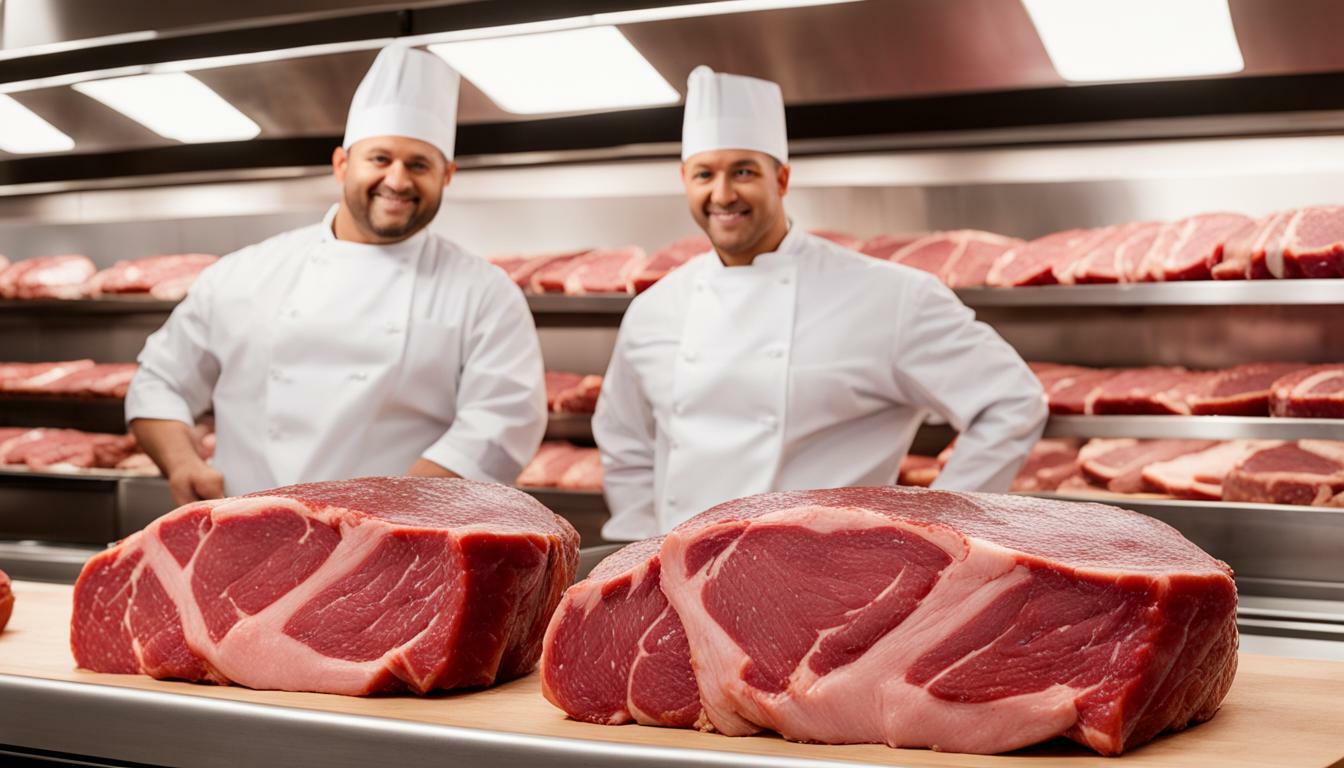
As a professional copywriting journalist, I often get asked about the differences between various cuts of meat. One common comparison is Rump Roast vs Round Roast. Both cuts come from the beef round section, but they have distinct characteristics that set them apart.
In this article, I will explore the differences between Rump Roast and Round Roast, including their flavor profiles, cooking methods, and ideal occasions for each. If you’re looking to up your cooking game and want to know which cut is better for which occasion, keep reading.
Contents
- 1 Rump Roast vs Round Roast: Comparing Flavor Profiles
- 2 Cooking Methods
- 3 Rump Roast vs Round Roast: Which is Better?
- 4 Rump Roast vs Bottom Round Roast vs Top Round Roast
- 5 Conclusion
- 6 FAQ
- 6.1 Q: What are the main differences between Rump Roast and Round Roast?
- 6.2 Q: How does the flavor of Rump Roast compare to Round Roast?
- 6.3 Q: What are the recommended cooking methods for Rump Roast and Round Roast?
- 6.4 Q: When should I choose Rump Roast over Round Roast?
- 6.5 Q: How does Rump Roast differ from Bottom Round Roast and Top Round Roast?
Key Takeaways:
- Rump Roast and Round Roast are both beef cuts from the round section of the cow.
- Rump Roast has more marbling and a richer, beefier flavor profile than Round Roast.
- Round Roast is leaner and milder in flavor, but can be enhanced with seasoning and proper cooking techniques.
- Rump Roast is best suited for slow cooking methods such as roasting or braising, while Round Roast benefits from marinating or brining beforehand.
- Both cuts have their own unique qualities and can be versatile in various recipes and cooking techniques.
Rump Roast vs Round Roast: Comparing Flavor Profiles
When it comes to flavor, Rump Roast and Round Roast have distinct differences. Rump Roast is known for its rich and beefy taste, thanks to the marbling that runs through the meat. It’s slightly more tender than Round Roast and often considered to be more flavorful. On the other hand, Round Roast has a leaner texture and milder taste compared to Rump Roast.
The good news is that both cuts of meat can be prepared in a variety of ways to suit individual tastes. Rump Roast is best for dishes that allow the meat to cook slowly, such as roasting or braising, to bring out its natural flavors. Round Roast, on the other hand, can benefit from a little help to enhance its mild flavor. This can be achieved by marinating it for a few hours before cooking or using herbs and spices to season it.
Ultimately, the choice between Rump Roast and Round Roast comes down to personal preference and the occasion. If you’re looking for a more special meal, Rump Roast is an excellent choice due to its rich flavor and tender texture. If you’re looking for something that can work well for everyday meals or when a lighter option is desired, Round Roast is the ideal choice due to its leaner profile.
Whichever you choose, Rump Roast and Round Roast are both flavorful and versatile cuts of meat that can be adapted to suit a variety of recipes and occasions.
Cooking Methods
When it comes to cooking Rump Roast and Round Roast, the best way to prepare them largely depends on personal preference and desired outcome. However, there are some cooking methods that tend to work best for each cut.
Rump Roast
Rump Roast is a flavorful cut that benefits from slow cooking methods. Roasting or braising are ideal techniques that allow the meat to cook low and slow, becoming tender and juicy while retaining its rich flavors.
For roasting, it’s recommended to sear the meat on all sides before placing it in the oven. This creates a crust that locks in moisture and flavor. Then, roast the meat at a low temperature (around 325°F) until it reaches an internal temperature of 135°F for medium-rare, or 145°F for medium.
For braising, sear the meat and then place it in a Dutch oven or slow cooker with vegetables and liquid (such as beef broth or red wine). Cook on low heat for several hours until the meat is tender and falling apart.
Round Roast
Round Roast is leaner than Rump Roast and requires a bit more care when cooking to ensure it stays tender and juicy.
Marinating or brining beforehand can help to tenderize the meat and add flavor. For roasting, it’s best to use a meat thermometer to ensure that the internal temperature reaches 135°F for medium-rare or 145°F for medium. Slicing thinly against the grain can also help to ensure tenderness.
Round Roast can also be sliced thin and used for dishes like roast beef sandwiches or stir-fries. Just be sure to not overcook the meat, as it can easily become tough.
Rump Roast vs Round Roast: Which is Better?
When it comes to choosing between Rump Roast and Round Roast, the decision ultimately boils down to personal preference and the occasion. Both cuts of beef have their unique qualities that make them suitable for different cooking needs.
For special occasions or holiday meals, Rump Roast is a popular choice. Its rich and beefy flavor, coupled with its tender texture, make it an excellent centerpiece for gatherings. On the other hand, if you’re looking for a leaner and lighter option for everyday meals, Round Roast may be the way to go.
Although Rump Roast is more flavorful and tender than Round Roast, the latter can be enhanced with the right seasonings and cooking techniques. Round Roast is leaner in texture and possesses a milder flavor, making it more versatile in cooking applications.
Regardless of which cut you choose, it’s essential to understand the differences between Rump Roast and Round Roast and how they affect your cooking. While Rump Roast is a rear section cut, Bottom Round Roast and Top Round Roast are derived from the upper leg. Bottom Round Roast tends to be leaner and less tender than Rump Roast, while Top Round Roast is thicker but also leaner.
Therefore, when choosing among Rump Roast, Bottom Round Roast, and Top Round Roast, consider the cooking methods and flavor profiles associated with each cut of beef. For Rump Roast, slow cooking methods such as roasting or braising work best to bring out its natural flavors. Round Roast can also be roasted or braised, but marinating before cooking will enhance its tenderness and flavor. Round Roast can also be sliced thin and used for dishes like roast beef sandwiches or stir-fries.
Ultimately, the choice between Rump Roast and Round Roast depends on your cooking needs and preferences. Both cuts can be versatile and suitable for various recipes, depending on personal preferences and cooking techniques.
Rump Roast vs Bottom Round Roast vs Top Round Roast
It’s important to understand the differences between Rump Roast and other cuts from the Round section. While Rump Roast comes from the rear section of the beef, Bottom Round Roast and Top Round Roast are derived from the upper leg. Each cut has its own unique qualities and it’s crucial to know which one to use based on your recipe requirements.
| Cut | Location | Texture | Flavor |
|---|---|---|---|
| Rump Roast | Rear section of the beef | Tender, marbled | Rich, beefy |
| Bottom Round Roast | Upper leg | Leaner, tougher | Milder |
| Top Round Roast | Upper leg | Thicker, leaner | Milder |
Bottom Round Roast tends to be leaner and less tender than Rump Roast. It benefits from using a slow cooking method like roasting or braising to achieve a tender texture. Meanwhile, Top Round Roast is a bit thicker than Rump Roast but similar in texture and taste. It’s best to marinate or brine it before cooking to ensure greater tenderness and juiciness.
Understanding the differences between these cuts can come in handy when selecting the right cut of meat for your dish. Whether you go for the tenderness of Rump Roast or the budget-friendliness of Bottom Round Roast or Top Round Roast, make sure to choose the right one for your recipe.
Conclusion
In conclusion, I have provided a thorough comparison of Rump Roast and Round Roast. By examining their differences in flavor profile, cooking methods, and ideal occasions, we can determine which cut of beef is best suited for various cooking needs.
Choosing the Right Cut
For special occasions or holiday meals, the rich flavor and tenderness of Rump Roast make it an excellent choice. On the other hand, Round Roast’s leaner profile is versatile for everyday meals and can be enhanced with the right cooking techniques.
Other Round Roast Cuts
It’s important to note the difference between Rump Roast and other cuts from the Round section. Bottom Round Roast tends to be leaner and less tender than Rump Roast, while Top Round Roast is thicker but also leaner. The cooking methods and flavor profiles for these cuts may differ slightly.
Overall, understanding the differences between Rump Roast and Round Roast, as well as other cuts from the Round section, can help you make informed decisions when choosing the right cut for your cooking needs. Whether you prefer the boldness of Rump Roast or the milder taste of Round Roast, both cuts have their own unique qualities to offer.
FAQ
Q: What are the main differences between Rump Roast and Round Roast?
A: Rump Roast and Round Roast have different flavors profiles, cooking methods, and ideal occasions for serving.
Q: How does the flavor of Rump Roast compare to Round Roast?
A: Rump Roast has a rich and beefy flavor with marbling that adds to its taste, while Round Roast has a leaner texture and milder flavor.
Q: What are the recommended cooking methods for Rump Roast and Round Roast?
A: Rump Roast is best suited for slow cooking methods like roasting or braising, while Round Roast can also be roasted or braised but benefits from marinating or brining beforehand.
Q: When should I choose Rump Roast over Round Roast?
A: Rump Roast is a popular choice for special occasions or holiday meals, thanks to its rich flavor and tender texture. Round Roast, with its leaner profile, is often favored for everyday meals or when a lighter option is desired.
Q: How does Rump Roast differ from Bottom Round Roast and Top Round Roast?
A: Rump Roast comes from the rear section of the beef, while Bottom Round Roast and Top Round Roast are from the upper leg. Bottom Round Roast is leaner and less tender than Rump Roast, while Top Round Roast is thicker but also leaner.
- 15 Amazing Cinder Block Grill Ideas - September 17, 2023
- 15 Brick Grill Ideas for Your Backyard - September 17, 2023
- 15 Stylish Built-in Grill Ideas for Your Backyard - September 17, 2023
